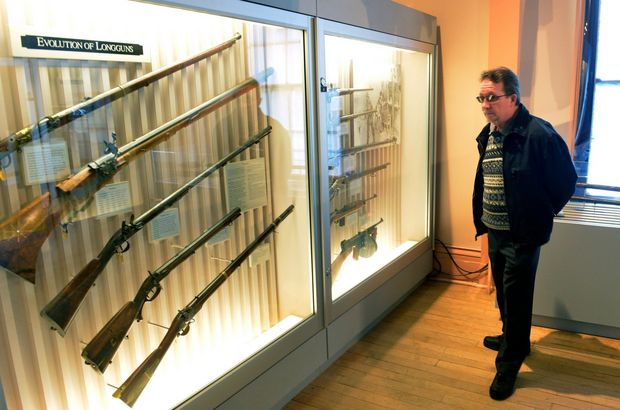Ever since the first motion picture was made in 1910, Hollywood has stirred the imaginations of millions of people around the world. Many of those movies, from swashbucklers and westerns to military and gangster films, have featured firearms designed and made in Springfield, home to the country’s first armory.
Now there’s a new exhibit that spotlights the city’s connection to the land of make-believe.
Although the weapons manufactured at the Springfield Armory were made exclusively for U.S. soldiers in real combat, Hollywood has found many uses for them, pressing them into action in hundreds of films.
Among them — Captain Blood, the 1935 film starring a then-unknown Australian actor named Errol Flynn in his first Hollywood leading role as a doctor turned buccaneer. It turns out that the pistol Flynn and fellow pirate Basil Rathbone were firing was a modified trapdoor rifle made by the Springfield Armory, according to curator Alex McKenzie.
“Hollywood manipulated those original firearms to look like something else, to be used as a pirate pistol, or an Arabic jezail or an old flintlock,” McKenzie says. “But it’s still the Springfield Armory underneath. They just added all these things and changed the wood and changed the length in order to make it fit whatever genre they were making.”
This often led to inaccurate depictions. As the film was set in the late 17th century, McKenzie says flintlock muzzle loading muskets should have been used instead of the trapdoor rifle. But he says the muskets took more time to reload. And in Hollywood, time is money.
“They had an idea of what was correct back then,” McKenzie says. “But there were certain ways, especially with big crowds and things that would only be seen from a distance, that you could get away with whatever you needed to do to get props in people’s hands.”
Another advantage of the trapdoor, says McKenzie, is that it used black powder as a propellant which, when ignited, makes a big puff of smoke, a theatrical tool that was indispensable for silent pictures.
In the modern film era, sound effects have embellished those theatrics. The armory display includes the Springfield-made M-1 rifle used by Roy Scheider to kill the shark in Jaws, as well as an original Connecticut-made Colt-Walker revolver and a replica made of rubber used by Clint Eastwood in The Outlaw Josey Wales.
“So this is a Colt-Walker,” McKenzie shows us. “This is unique in that it’s very large and very heavy. Again you get a sense of its weight…It is not light for a pistol for something that’s meant to be held with one hand.”
“And so you can see in doing action scenes…here’s the rubber stunt model, [it’s] only a few ounces really,” he says. “So not only in terms of safety, but — jeez — in terms of stamina, in terms of carrying these things around all the time, there’s definitely value in having something so light. But it’s a stark contrast between a real original and a rubber prop.”
For Dan Habel, a Springfield native who’s recently returned home after living in the Los Angeles area for 25 years, the exhibit brings together two interests of his, films and local history.
“How do you take a Springfield-era gun and turn it into a laser, you know, shooter or whatever? And just the magic, the wizardry of Hollywood is pretty cool,” Habel says. “But realizing, ‘Hey, why recreate the mousetrap? Let’s just color it and change it a little bit and go from there.’ So that was cool to see.”
About two dozen pieces, including a half dozen from its own 10,000 piece collection, are in the exhibit, Springfield Armory Goes To Hollywood. It’s on display through the end of September.
